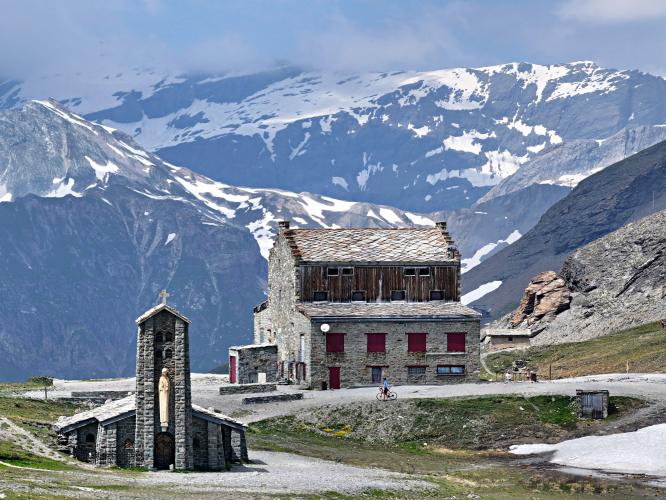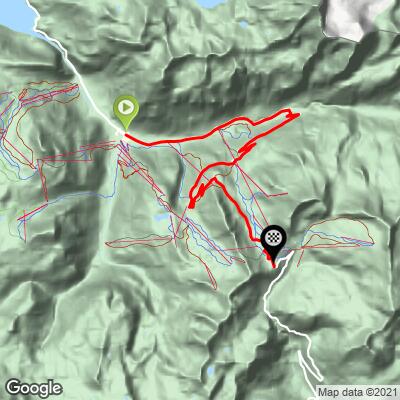![Cycling Col de L'Iseran: sign for Col de L'Iseran]()
Col de L'Iseran - one of the most spectacular cycling climbs in the world.
Ride 16.2 kilometers gaining 929 meters at 5.7% average grade.
From either direction, Col de L’Iseran is one of the most scenic and epic bike climbs in all of France. The approach from Val d'Isère is the most epic and mountainous, while the approach from Bonneval-sur-Arc is both scenic and a bit more challenging. From Val d'Isère we ride past ski slopes up to magnificent mountain formations above tree line, depending on the time of year, to Lac de l’Ouillette (the lake could be frozen).
![Cycling Col de L'Iseran: photo collage shows old cobblestone church, PJAMM cyclist riding on large curve in mountain roadway, bike parked next to road sign for Col de L'Iseran]()
Col de L’Iseran is the highest paved mountain pass in France and the entire Alps.
Col de L’Iseran is located in France’s Graian Alps, within the Savoie department, and close to France’s boarder with Italy. The col is part of the Route des Grandes Alpes, and connects the Isère Valley with the Arc River (Maurienne) Valley. Along the route is the Tignes-Val d'Isère ski resort, part of the reason this is a popular attraction in the right seasons. Also of note is that this col is home to the highest point on the long-distance trail, the Alpine GR 5, which connects Lake Geneva to Nice. Along the steep descent visitors can expect to see many waterfalls, as the col enters the Vanoise National Park.
THE FIRST SEGMENT OF THE CLIMB
![Col de L’Iseran from Val d'Isère - start Bicycle ride of Col de L’Iseran from Val d'Isère - buildings in town and start of climb]()
Climb begins in Val d'Isère.
Val d'Isère is on the border of the Vanoise National Park (est. 1963; 534 square kilometers/131,954 acres). Val d'Isère ski resort is quite famous, having hosted the 1992 Winter Olympic men’s downhill race and many World Cup alpine events. The ski areas of Val d'Isère and Tignes are named Espace Killy after three-time olympic champion Jean-Claude Killy who grew up in Val d'Isère.
![Cycling Col de L'Iseran: view from under Pont St. Charles Bridge]()
Pont St. Charles bridge.
We pass by a beautiful meadow with a couple old farming buildings and over a stone bridge at kilometer 4.9, just before reaching hairpin #1.
![Cycling Col de L'Iseran: photo collage shows yellow wildflowers in meadow at kilometer 4.9]()
Pont St. Charles 3.6 mile hike begins at the bridge just before our first hairpin at kilometer 4.9.
![Cycling Col de L'Iseran: photo collage showing vies from hairpin #1, kilometer 5; PJAMM cyclist riding on two-lane mountain roadway, stone kilometer markers in green hillsides speckled with yellow wildflowers]()
Photos as we approach and pass hairpin #1 at kilometer 5.
THE MIDDLE SEGMENT OF THE CLIMB
![Cycling Col de L'Iseran: photo collage shows PJAMM cyclist riding on huge hairpin turn; green, alpine landscape]()
Second set of two giant hairpins at kilometer 7.5 averaging 5.3%.
![Cycling Col de L'Iseran: stone bridge at kilometer 8.5; pink and yellow wildflowers growing in mountainside fields]()
Bridge at kilometer 8.5.
There are many streams running down the mountain and under the road as we climb towards Col de L’Iseran from Val-d’Isere.
![Cycling Col de L'Iseran: photo collage shows views along middle portion of climb; alpine lake in distance, snow-dotted mountain peaks; green hillsides]()
Views along the middle of the climb.
![Cycling Col de L'Iseran, France Cycling Col de L'Iseran: photo collage shows vies along the middle and upper portions of the climb, above the town of Val d'Isere; pockets of snow dotting landscape, long narrow mountain road snakes its way up mountain]()
Views along the middle to upper portion of climb, above Val d'Isère.
THE FINAL KILOMETER TO THE TOP
![Cycling Col de L'Iseran: photo collage shows views of blue water in unnamed pond shortly before climb's finish; snow patches in fields]()
We pass an unnamed pond just 800 meters from the col.
![Cycling Col de L'Iseran: photo collage shows PJAMM cyclist riding final, steep kilometer of the climb; snow patches along roadway up to climb finish]()
The final kilometer to the Col is the steepest, averaging 7.7%.
KILOMETER MARKERS
![Cycling Col de L'Iseran, France Cycling Col de L'Iseran: photo collage shows yellow and white km markers along route]()
There are kilometer markers at most km points along the climb.
![Cycling Col de L'Iseran, France Cycling Col de L'Iseran: photo collage shows yellow and white km markers along route]()
Col de L'Iseran is part of the Route des Grandes Alpes, a tourist itinerary that begins in Thonon-les-Bains and travels over many of the most spectacular passes in France and Europe, including Col de L'Iseran, Galibier, d’Izoard, and Bonette; alternate route includes Croix de Fer and Madeleine.
![Cycling Cime Bonette from Jausiers, France Cycling Cime Bonette from Jausiers, France - Route des Grands Alpes map]()
Route des Grandes Alpes.
THE TOP - COL DE L’ISERAN
![Cycling Col de L'Iseran: photo collage shows street signs for Col de L'Iseran; climb finish]()
![Cycling Col de L'Iseran: photo collage shows informational signs and plaques at climb finish]()
Col de L'Iseran is #30 in Hugh Merrick’s book The Great Motor Highways of the Alps, in which he writes that “the impression that emerges, rather like the stunning vistas of the Chalanson and Albaron glaciers as one nears the summit from the southern side, is of a feat of road building that was also in part a vanity project.”
![Cycling Col de L'Iseran: aerial drone view of the top of Col de L'Iseran; snow-dotted mountain peak]()
Aerial view of Col de L'Iseran
Approach from Bonneval-sur-Arc to right and from Val-d’Isere left.
You may wonder: Is Col de L'Iseran truly the highest paved pass in Europe?
The answer is yes. While Pico de Veleta (Spain), is the higher “road” at 3,357 m/11,013’, it ends in a deadend so is not a pass. Even though Cima de la Bonette (2,685 m/3,809’) is technically a pass, it is just a through-road to the peak and not the functional “pass.” Thus, Col de L'Iseran, with its functional col/pass at 2,633 m/8,638’ can truly claim “highest paved pass in Europe.”
CHAPEL NOTRE-DAME DE TOUTE PRUDENCE
![Cycling Col de L'Iseran: aerial drone view shows Chapel Notre-Dame de Toute Prudence nestled in peak of mountain, surrounded by patches of snow]()
Chapel Notre-Dame de Toute Prudence is located at the Col de L’Iseran.
![Cycling Col de L'Iseran: views of Chapel Notre-Dame de Toute Prudence]()
Construction of the chapel was completed in 1939 using local stone. The sculpture of the Virgin Mary was created by sculptor Edgar Delvaux.
![Cycling Col de L'Iseran: black and white views of Chapel Notre-Dame de Toute Prudence]()
Tour de France History
TOP 10 MOST FREQUENT CLIMBS OF THE TOUR DE FRANCE
AND 10 FAMOUS ONES AFTER THAT
As of 2023 Col de L’Iseran has been featured eight times in the TdF.
Each time it has been featured, it has also been the highest point in that year’s TdF.
© PJAMMCycing.com
© Climb name | Elevation (meters) | Times highest point of TdF (as of 2022) | Mountain Range | Times Featured in Tour de France | Most recent | First included |
Cime de la Bonette | 2,802m | 4 | Alps | 4 | 2008 | 1962 |
Col de l'Iseran | 2,770m | 8 | Alps | 8 | 2019 | 1938 |
Col Agnel | 2,744m | 1 | Alps | 2 | 2011 | 2008 |
Col du Galibier | 2,642m | 50 | Alps | 63 | 2022 | 1911 |
Col du Granon | 2,413m | 0 | Alps | 2 | 2022 | 1986 |
Col de L’lseran has been the highest point in the TdF eight times.
Also see Top 10 Highest Points of the TdF.
Col de L'Iseran has only been included in the Tour de France eight times in the 85 years between 1938 and 2023. The Tour takes what is otherwise a somewhat eerie and desolate -- although quite scenic -- place, and turns it into a tourist attraction with a carnival atmosphere. First included in the Tour in 1938, Gino Bartali exclaimed that he won the race on his descent of Col de Vars, but saved it on the descent off the L'Iseran.
![Col de l’Iseran Gino Partali, Tour de France 1938]()
Gino Bartali, winner 1938 Tour de France
Bartali crossed L'Iseran in Stage 14
Down 00:01:05 at the beginning of the stage, after a heroic descent of L'Iseran he finished up 00:05:18.
Photo: LearningHistory.com
Bartali (along with Federico Bahamontes) has more Grand Tour wins (9) than anyone in history and the TdF (1938, 1948), Giro (1936, 1937, 1946; mountain classification a record seven times, three more than anyone in history, Giro wasn’t held five years from 1941-1945), Milan-San Remo (4) and Giro di Lombardia (3).
It was on Col de L'Iseran that legendary cyclist Louison Bobet’s career ended. Bobet retired at the summit of L'Iseran on July 14, 1959, having been victorious in the TdF three years running from 1953-55. Bobet was the first rider to win the Tour de France in three consecutive years.
![Col de l’Iseran Louison Bobet, 1959 Tour de France]()
Louison Bobet on Col de L'Iseran 1959 Tour de France
Bobet retired on L'Iseran July 14, 1959 after three TdF victories.
Photo: Walter Vermeulen flicker
July 9, 1963 is notable more for the brutal conditions on the L'Iseran than for the race stage itself (won by undisputed King of the Mountains Fernando Manzaneque -- winner mountain classification TdF six times, Giro d’Italia once, and Vuelta de Espana twice). Due to impassable snow pack at the top of Col de L'Iseran, the tour came within a whisker of a tedious and long reroute around Albertville and Bourg Saint Maurice of the 202 km stage from Grenoble to the scheduled finish in Val d'Isère. However, the tour organizers, having more consideration for their business and schedule than the riders’ safety, maintained the original route which led the tour over the high pass along icy roads and a snow tunnel.
![Col de l’Iseran 1963 Tour de France]()
Col de L'Iseran -- Stage 16, Tour de France July 9, 1963.
Photo: innrng.com
![Col de l’Iseran Tour de France cyclists ride through tunnel in 1963]()
Near the summit of L'Iseran TdF 1963
Photo: innrng.com
Likely the most famous of the eight crossings of the L'Iseran during the Tour de France involved the amazing solo 100 kilometer breakaway by Italy’s Claudio Chiapucci, a true Mountain King. Chiapucci has legendary mountain classification credentials -- one of only four men to win the TdF and Giro mountain classification in the same year (putting him in the enviable company of Fausto Coppi, Charly Gaul and Lucien Van Impe), and tied with Gino Bartali with the most Giro mountain classification wins (7). With 100 kilometers to go on July 18, 1992’s TdF Stage 13, Chiapucci did one of his signature (though sometimes ill-advised) breakaways. However, on this day the peloton mistakenly ignored Chiapucci who burned over seven cols, including the highest of them all, L'Iseran, on his way to a 00:01:34 stage win. Chiapuccu was second in that year’s Tour to Miguel Induran who won his second of an unbelievable five straight Tours de France.
![Col de l’Iseran Claudio Chiapucci (KOM jersey) and Miguel Indurain (leader’s jersey)]()
Claudio Chiapucci (KOM jersey) and Miguel Indurain (leader’s jersey). Indurain is the 1991 & 1992 TdF
mountain classification winner.
Photo: cyclingweekly.com

 We've partnered with Sherpa-Map.com to bring you the best route planning tool. With a PRO Membership you can use this climb as a reference when creating your route.
We've partnered with Sherpa-Map.com to bring you the best route planning tool. With a PRO Membership you can use this climb as a reference when creating your route. 


